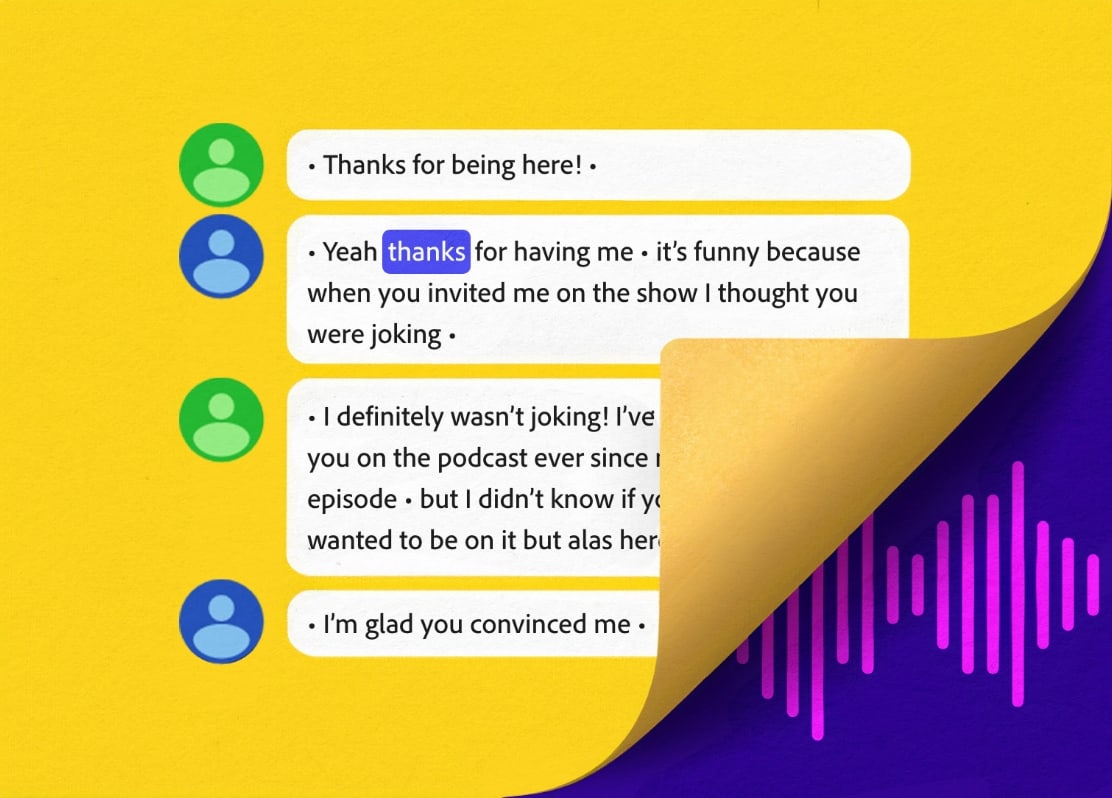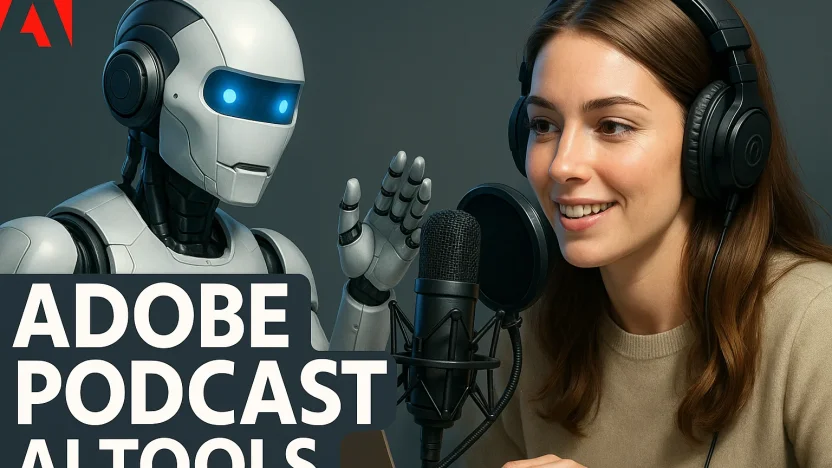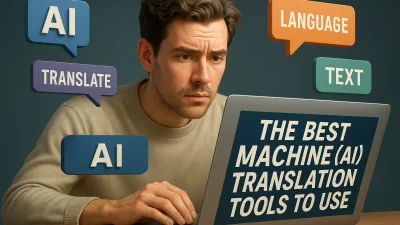Adobe Podcast AI is changing how serious producers ship episodes. If you manage a content pipeline, you know the grind: messy guest audio, uneven levels, long edit cycles, transcripts that never align. With Adobe’s browser-based tools plus Audition on the desktop, we can compress that cycle—cleaner sources, tighter edits, faster review—without adding headcount.
Podcast ad spend isn’t slowing either, which means quality and speed now compound ROI. (IAB/PwC projects U.S. podcast ad revenue to exceed $2B and approach ~$2.6B by 2026.)

At TopTut, we build tools for operators and marketers who need predictable outcomes. Below, we reframe the original overview into an operator-grade blueprint: where Adobe’s AI helps, where it doesn’t, how to wire a durable workflow, and which KPIs actually move. When you’re juggling hosts, guests, and sponsors, this is the difference between “sounds okay” and “sounds premium—every week.”
AI Adobe Podcast Tools: Pros and Cons
| Pros of Adobe Podcast AI Tools ????️ | Cons of Adobe Podcast AI Tools ???? |
|---|---|
| Advanced editing ✂️ — Transcript-based edits, spectral repair, multitrack mixing help teams ship faster with fewer artifacts. | Learning curve ???? — Spectral workflows and effect chains can overwhelm new editors without a documented preset stack. |
| Noise cleanup ???? — Enhance Speech and adaptive noise reduction salvage sub-optimal guest audio. | Subscription cost ???? — Multiple seats across Creative Cloud can pinch smaller shows without sponsor backing. |
| Speech enhancement ????️ — More intelligibility at lower playback volumes; better perceived production value on mobile. | AI artifacts risk ????❗ — Overuse can create “over-polished” or phasey voices; requires tasteful thresholds. |
| Throughput ⏰ — Repeatable chains + batch processing cut edit time per episode. | Glitches happen ???? — Browser sessions and large multitrack projects occasionally hiccup; versioning discipline is required. |
| Transcription ???? — Text edits and captions accelerate clipping and distribution. | Accuracy variance ???????? — Accents, jargon, and crosstalk can dent transcription accuracy; human spot-edits still matter. |
Key takeaways
- Adobe’s Podcast stack accelerates cleanup and assembly; use AI for speed, not as a crutch.
- Preset chains (per host/guest) turn “AI magic” into repeatable outcomes.
- Transcripts unlock search, repurposing, and shorts—if you enforce a naming/versioning scheme.
Need text-to-clip speed? Try our free transcript-to-snippets worksheet—designed for editing by script, not timeline.
The Power of Adobe Podcasting
Adobe’s ecosystem covers the full journey: capture, cleanup, mixing, mastering, and packaging. On the web, Adobe Podcast Studio handles recording, transcription, and first-pass enhancement; on the desktop, Audition brings surgical control. The practical win for teams: fewer context switches and simpler handoffs between producer, editor, and social lead.

Audition’s waveform and multitrack editors plus spectral display give you three levers: fix the problem, hide the problem, or re-record around the problem. We standardize on host and guest effect racks (EQ, de-esser, gentle compression, limiter) and keep a separate chain for remote guests that leans more on restoration.
On the browser side, Enhance Speech and auto-leveling are genuinely useful when time is tight or a guest’s environment is noisy. Adobe documents this directly—cleaning background noise and boosting clarity with one click (Enhance Speech).
The Power of Adobe Podcasting (video workflows)
Let’s face it: video is now part of “podcasting.” YouTube is the most used service for weekly podcast listening, which makes thumbnailing, captions, and chapter markers operational priorities (Edison Research, 2025). Use Premiere Pro for multicam and shorts; route final dialogue back through Audition for a consistent sonic signature across audio-only and video cuts.
Creative Cloud Libraries keep bumpers, SFX, and ad reads consistent across editors. Shared presets and a style guide beat “golden ears.” Discipline wins.
Want automated geo-gating for sensitive creative? Our utilities can help enforce country-level rules across your embeds.
Unleash potential with AI
AI is best treated as assistive automation: fast denoise, consistent EQ targeting, gentle dynamics, text-based edits, and speaker labeling. Overdo it and voices get plasticky. Used well, you’ll cut human time while improving MLR (mean listening retention) and ad audibility.
What we operationalize: set max gain reduction for denoise; cap broadband NR to moderate settings; use dynamic EQ to tame 3–5 kHz harshness; cap brickwall limiting around −1 dBTP to protect platforms. Lock it as a rack preset per voice. “Tasteful and repeatable” beats “max AI.”
Yes, Enhance Speech can rescue rough takes, and Adobe now runs an updated model with stronger reverb and chatter suppression (Enhance Speech v2). Use it as a first pass; fine-tune in Audition where needed.
Simplify Editing with Adobe Audition
Audition is where professional control lives. The multitrack view supports clip-based processing, clip gain rides, and real-time effect chains; the waveform view is for surgical fixes. The spectral editor lets you paint out coughs, chair squeaks, and phone buzz without mangling speech.

We recommend three session templates: Interview (host, guest, remote backup), Roundtable (four speakers with sidechains on crosstalk), and Narrative (VO, music beds, SFX busses, limiter on mix bus). Lock your loudness target at −16 LUFS for stereo and keep true-peaks below −1 dBTP for platform safety.
Audition features that matter
| Feature | Why it moves KPIs |
|---|---|
| Batch processing | One-click loudness and export profiles reduce cycle time per episode and increase release reliability. |
| Automatic speech alignment | Snaps multitrack conversations into sync; cuts manual edit time and reduces listener fatigue from drift. |
| Effect racks & presets | Standardizes voice tone across episodes—brand consistency for your sound. |
| Spectral editing | Removes intermittent noises without nuking intelligibility; improves perceived quality on earbuds. |
Looking to streamline post-episode reporting? Test our free episode KPI template: retention, ad audibility, and export timings on one sheet.
Harness the Power of Adobe Sensei
Sensei is the AI spine behind much of the “that was fast” experience: automatic speech alignment, intelligent cleanup, and smarter levels. It’s not a substitute for taste, but it’s an excellent accelerator. Use it to remove the repetitive work so editors can focus on narrative pacing, ad integration, and pull-quotes.
Our rule: automate the first 70% of cleanup; reserve the last 30% for human judgment. That’s how you keep the voice natural and the brand intact.
Need real-time click-to-conversion data from episode links? Try our free tracking helpers—UTM builder + redirects—so podcast CTAs actually attribute.
Integrate Adobe Podcast AI Into Your Workflow
Good tools can’t save a chaotic pipeline. Wire the workflow first, then layer AI. Below is a simple operator view of where Adobe’s tools sit and which metrics they should move. Have you considered the downstream impact of switching attribution methods on sponsorship reporting? You should.
| Stage | KPI moved | How we operationalize with Adobe |
|---|---|---|
| Capture | Noise floor, clipping rate | Record in browser (Podcast Studio) or local WAV; enforce mic checks and level targets; remote guests on separate tracks. |
| Cleanup | Intelligibility score, edit time | First-pass Enhance Speech; conservative NR thresholds; dynamic EQ for sibilance; save per-voice presets. |
| Assembly | TAT to first review, error rate | Transcript edits for content cuts; chapter markers; ad markers as separate clips for swaps. |
| Mastering | Loudness compliance, peak control | −16 LUFS stereo targets; limiter at −1 dBTP; audition on phone speakers and buds. |
| Distribution | MLR, ad audibility, CTR | Consistent intro/outro, mid-roll volume parity; export captions; UTM’d links in show notes. |
| Tip | Review Adobe’s docs and quick guides before you lock presets; align on loudness, denoise ceilings, and export profiles to prevent drift across editors. |
|---|
Hardware matters less than discipline. A decent dynamic mic into any clean interface, quiet room, and consistent mic technique will outperform “AI everything” in a reflective space. AI should amplify fundamentals, not replace them.
“We moved from timeline-first edits to transcript-first assembly. Same team, half the time, better sound.” — Production Lead, B2B show
Want automated show-notes from your transcript? Our formatter converts transcripts into skim-friendly notes with timestamps and chapters.
Elevate Content with Adobe Podcast AI
It’s frustrating when a strong interview falls flat because of room echo or HVAC rumble. AI remediation plus human taste restores the conversation’s energy. Automatic speech alignment fixes drift on double-enders. Intelligent cleanup removes low-value noise. Voiceover ducking keeps the host on top of the music bed without babysitting faders.
The payoff shows up in listener behavior: clearer dialogue sustains attention, which lifts mid-roll performance and organic sharing. If you’re cutting shorts for YouTube, keep a separate mastering preset tuned for platform norms; what sounds perfect at −16 LUFS in the feed can feel subdued beside music-forward shorts.
“Enhance + light EQ gave us broadcast-like consistency across remote guests. Listeners noticed.”
Clipping reels from transcripts? Our free snippet planner helps you pick moments with built-in hook prompts.
Stay Ahead with Continuous Innovation
Podcasting isn’t just audio anymore—audiences increasingly watch episodes, and platforms reward video-ready packaging. That’s where Adobe’s ongoing updates to Enhance Speech and browser-based recording matter; they shrink the distance between raw capture and publishable assets. The industry’s momentum toward video discovery is real, and Adobe’s stack keeps pace (Edison shows YouTube leading weekly podcast listening share among services).
Here’s the bottom line: standardize your chain, automate the repetitive 70%, and invest human attention where it pays—story beats, pacing, and sponsor fit. The stack should disappear behind a consistent sound that audiences trust.
Conclusion
Use Adobe’s AI to make your team faster and your show more consistent. Build presets per voice. Keep denoise gentle. Master to platform targets. Track the impact with a simple scorecard: retention, ad audibility, edit hours per episode, and time-to-publish. If you do that, quality scales without drama.
One last question to stress-test your pipeline: if you switched to transcript-first edits tomorrow, how many episodes could you ship per month with the same team? If the answer isn’t “more,” your presets and handoffs need work.
Need a starting point? Grab our free episode KPI sheet and transcript formatter—then layer Adobe’s Enhance Speech on capture days that don’t go to plan.
Appendix: Fast Operator Setup
- Session templates — Interview, Roundtable, Narrative; premapped busses; loudness presets.
- Voice racks — Host, Guest-local, Guest-remote; EQ → de-esser → comp → limiter; separate cleanup chain.
- Export profiles — Feed (−16 LUFS stereo), Trailer/Ad (slightly louder), Shorts (platform-tuned).
- Versioning — YYYY-MM-DD_Ep##_v1, v2; commit notes; store presets in Libraries.
Want automated geo-gating for campaign assets inside show notes? Our tools can help.
Operator Table: Tactic → KPI → How We Do It
| Tactic | KPI moved | TopTut operationalization |
|---|---|---|
| Enhance Speech on guest tracks | Retention, ad audibility | Apply conservative model; human pass for artifacts; preset per guest profile. |
| Transcript-first editing | Edit hours, error rate | Cut by script; chapter markers; ad markers in transcript; export captions. |
| Preset loudness & limiter | Platform consistency | −16 LUFS stereo; −1 dBTP ceiling; earbuds spot-check. |
| Multitrack templates | TAT to review | Pre-routed busses, VO ducking on beds; shared Libraries. |
| Show-notes automation | CTR, discoverability | Generate summaries and timestamps from transcripts; UTM’d links. |
Looking to streamline partner reports from podcast campaigns? Test our reporting templates.





[…] source http://www.toptut.com/adobe-podcast-ai-tools-enhancing-your-podcasting-experience/ […]
[…] in and recommends, earning trust and credibility among his followers. Through his website and podcast, he generates six-figure monthly income, much of which comes from affiliate […]
[…] don’t stop at blog posts or articles – explore other types of content, like videos, podcasts, infographics, or social media posts. Experiment with different formats to see what resonates with […]
[…] with 24/7 customer support and a wealth of resources such as articles, podcasts, and webinars, you’ll have all the support you need to help your online business […]
[…] let’s not forget about iHeartRadio’s podcast selection. It offers a diverse range of podcasts on various topics, from true crime to pop culture […]
[…] to repurpose your blog content for other marketing channels. By sharing your blog posts, videos, or podcasts across different platforms frequented by fellow bloggers or within blogging communities, you can […]
[…] or a professional audiophile, YouTube-to-WAV converters can elevate your listening experience. From podcasts to music videos, you can convert any content from YouTube into a high-quality WAV file and enjoy it […]
[…] podcasts. No, we’re not talking about the latest true crime hit. We’re talking about language […]